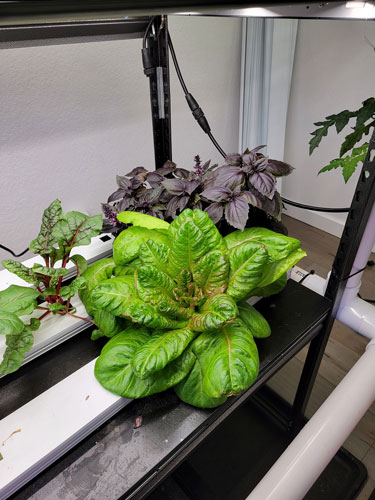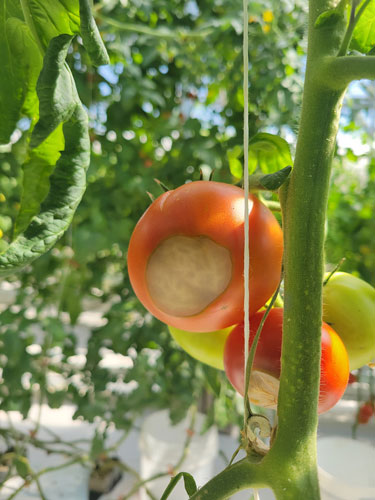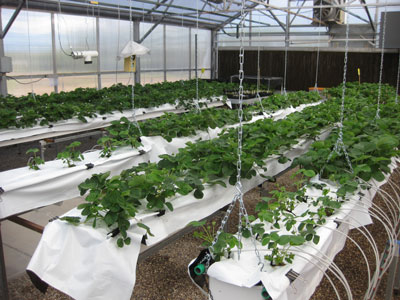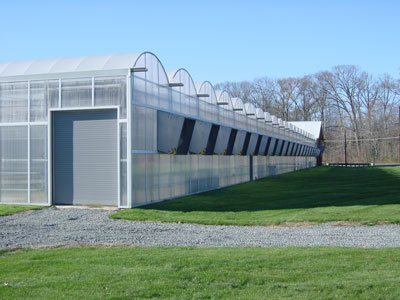11/1/2022
Why Should You Care About VPD?
David Kuack

Controlled environment growers are focused on providing their crops with the optimal temperatures and relative humidity whether they’re growing in a greenhouse, vertical farm or indoor grow. Maintaining the proper environment ensures their crops finish on time with the maximum yields and quality. Not being able to control the growing environment can lead to issues with disease, insect pests and crop loss.
While the relative humidity indicates the amount of water the air can hold at a specific temperature, it doesn’t provide any information about how much water plants are transpiring.
“Plants growing in a greenhouse, vertical farm or indoor grow are surrounded by air,” says Dr. Nadia Sabeh, president at Dr. Greenhouse Inc. “That air has moisture in it. The amount of moisture in the air affects the vapor pressure of that air.
 “Vapor pressure deficit (VPD) is the difference in the pressure in the air and the pressure at the leaf surface. At plant level, the leaf stomata are taking in carbon dioxide for photosynthesis and releasing water vapor and oxygen. The water vapor at the stomata is technically liquid water before it evaporates. The vapor pressure deficit is the pressure on the plants to evaporate water.”
“Vapor pressure deficit (VPD) is the difference in the pressure in the air and the pressure at the leaf surface. At plant level, the leaf stomata are taking in carbon dioxide for photosynthesis and releasing water vapor and oxygen. The water vapor at the stomata is technically liquid water before it evaporates. The vapor pressure deficit is the pressure on the plants to evaporate water.”
Pictured: If calcium cannot reach new cells in adequate time, this can result in necrotic (dead) tissue in the leaves (lettuce tipburn) and fruit (tomato blossom end rot).
Photos courtesy of Nadia Sabeh, Dr. Greenhouse.
Growers who are targeting to maintain a specific temperature and humidity, for example 75F and 60% relative humidity, have a vapor pressure associated with those environmental conditions. When the relative humidity is low and the air is dry, the vapor pressure deficit is high.
“Under a high VPD, there is a high pressure on plants to transpire and to evaporate water,” Nadia says. “If there is a lot of moisture in the air and the relative humidity is high at the same temperature, then the VPD is low and there is less pressure on the plants to transpire and to evaporate water.”
She adds it is important to control VPD with controlled environment crops because it directly affects how much water plants will transpire and how much nutrients are delivered and distributed to various parts of the plants. In a controlled environment, growers have the advantage to control the vapor pressure of the air by managing the temperature and humidity, while outdoor growers have to deal with the weather that’s occurring. In a controlled environment, growers can choose the vapor pressure they want to maintain in order to control how plants transpire, and use water and nutrients.
Consequences of poor VPD control
VPD impacts all parts of the plant. If the VPD is very low and the air is very humid, condensation can form on flowers and leaves that can promote disease and provide pests with a favorable environment.
“If the VPD is really high and the relative humidity is low, powdery mildew spores can spread more easily because they travel in dry air,” Nadia says. “If the VPD is really low and the humidity is high, there is also a higher chance of Botrytis and other airborne pathogens infesting the plants.
“If there is a high VPD and the air is really dry, the plants are going to transpire more, resulting in greater water use. As long as plants continue to be irrigated, they can use as much water as they are given, which could actually decrease the water use efficiency.”
A telltale sign of poor VPD control is calcium deficiency in the various parts of a plant.
“When it comes to calcium deficiency, it can occur in all plants with leaves,” Nadia notes. “The leaf stomata are responsible for releasing moisture and affecting transpiration. The first place water is going to go is to the leaves, which is often the first place calcium deficiency appears.”
She adds symptoms of calcium deficiency are a yellowing edge or browning around the leaf tips because the calcium moves to that part of the plant through the transpiration process. In fruiting plants like tomatoes, cucumbers and peppers, calcium deficiency appears as blossom end rot, which is a darkening bottom of the fruit. A tomato with blossom end rot looks like it’s rotting. Nadia says this is kind of a misnomer because it’s not rot at all, it’s a calcium deficiency.
Impact of growing structure, climate on VPD
Nadia says the type of growing structure along with climate can impact the ability of growers to control VPD. In closed vertical farms and warehouse facilities, the indoor environment isn’t as influenced by the outdoor environment. In these operations, growers usually use air conditioning. Some outside ventilation air may also be delivered during certain times of the year.
 “Theoretically, because closed facilities are usually independent of the outdoor weather and there is an HVAC system that can be designed, sized and operated exactly to meet temperature and humidity targets, it should be easier to control VPD in closed facilities than in greenhouses,” Nadia says. “However, it can be more challenging to control the VPD in a vertical farm than in a single-level vertical grow. In a vertical farm, it can be difficult to move the air throughout the different levels of the production system. In a vertical farm, it can be more difficult to control VPD because there tends to be more microclimates than in a single-level indoor grow.”
“Theoretically, because closed facilities are usually independent of the outdoor weather and there is an HVAC system that can be designed, sized and operated exactly to meet temperature and humidity targets, it should be easier to control VPD in closed facilities than in greenhouses,” Nadia says. “However, it can be more challenging to control the VPD in a vertical farm than in a single-level vertical grow. In a vertical farm, it can be difficult to move the air throughout the different levels of the production system. In a vertical farm, it can be more difficult to control VPD because there tends to be more microclimates than in a single-level indoor grow.”
Pictured: Even though an evaporative cooling system may add moisture to the air, the humidity in a greenhouse can be dry because the outside climate is dry, resulting in high VPDs.
Photo courtesy of Mark Kroggel, The Ohio State University.
The greenhouse environment is much more susceptible to what’s happening outside the structure than in a vertical farm or warehouse. She says because greenhouses use outside air to ventilate and operate evaporative pad-and-fan cooling systems, they tend to have a build-up of humid air during the night when they’re closed. Also, the glazing material on a greenhouse can impact VPD; a greenhouse covered with glass or plastic panels tends to have leaks and gaps, whereas structures glazed with polyethylene film—which is a single covering—have a lot less infiltration and exfiltration that can let humidity in and out of the greenhouse.
The type of cooling system can impact control of VPD as well. “Evaporative cooling systems are more effective in dry climates than in humid climates,” Nadia says. “Even though a grower may be using evaporative cooling and actively adding moisture to the air, the humidity in the greenhouse can be dry because the outside climate is so dry, resulting in high VPDs.
“In climates where it can be very humid, evaporative cooling doesn’t work well because it is so humid and the VPD is already really low. Under these conditions it is difficult to dry the air and remove moisture from the greenhouse environment. In these cases, the option of using dehumidifiers or air conditioning to achieve the optimum VPD is not very energy efficient.”
Maintaining the proper VPD
VPD isn’t a measured variable; it’s a calculated variable. “There is a discussion occurring in the industry now as to whether to use the VPD of the air or the VPD of the leaf as the control point,” Nadia says. “As long as a grower is looking at both the temperature and humidity, and considering whether the vapor pressure deficit is based on the air or the leaf temperature, the grower is already ahead of the game.”
 Pictured: Greenhouse glazing material can impact VPD. A greenhouse covered with glass or plastic panels tends to have more leaks and gaps than one covered with polyethylene film.
Pictured: Greenhouse glazing material can impact VPD. A greenhouse covered with glass or plastic panels tends to have more leaks and gaps than one covered with polyethylene film.
Photo courtesy of A.J. Both, Rutgers University.
According to Nadia, there are sophisticated control systems available that have the equations and algorithms to make the necessary predictions. These systems allow growers to set a VPD target and then use the measurements from temperature and humidity sensors to tell the environmental control equipment exactly what to do to reach the desired VPD.
For growers with less sophisticated control systems, they can use temperature and humidity sensors to collect the data to determine the VPD. Nadia has her own VPD calculator app available, which enables growers to plug in the temperature and humidity from their sensors to determine the VPD and whether the environment is too dry or too humid.
“Depending on the growing structure and HVAC equipment available, growers can then make adjustments to the VPD. Regardless of whether a grower has to make manual adjustments or has a control system that can do so automatically, it comes down to monitoring the temperature and humidity and then determining what is the equivalent vapor pressure deficit under those conditions,” Nadia says. “In a controlled environment, growers are looking to find the sweet spot, the balance between the air being too dry and being too wet to avoid the potential issues associated with a VPD that is too high or too low.” IG
Achieving a Target VPD
Trying to achieve a target vapor pressure deficit depends on several factors including:
• The location and type of growing structure
• The outside climate, especially in the case of a greenhouse
• The crop grown
• The season during which a crop is grown
• The type of HVAC equipment required to control VPD
• How tightly a grower wants to control VPD during the entire cropping cycle
Click the link to access Nadia Sabeh’s VPD calculator. https://www.doctorgreenhouse.com/vpd-calculator
David Kuack is a freelance technical writer in Fort Worth, Texas. He can be reached at dkuack@gmail.com.